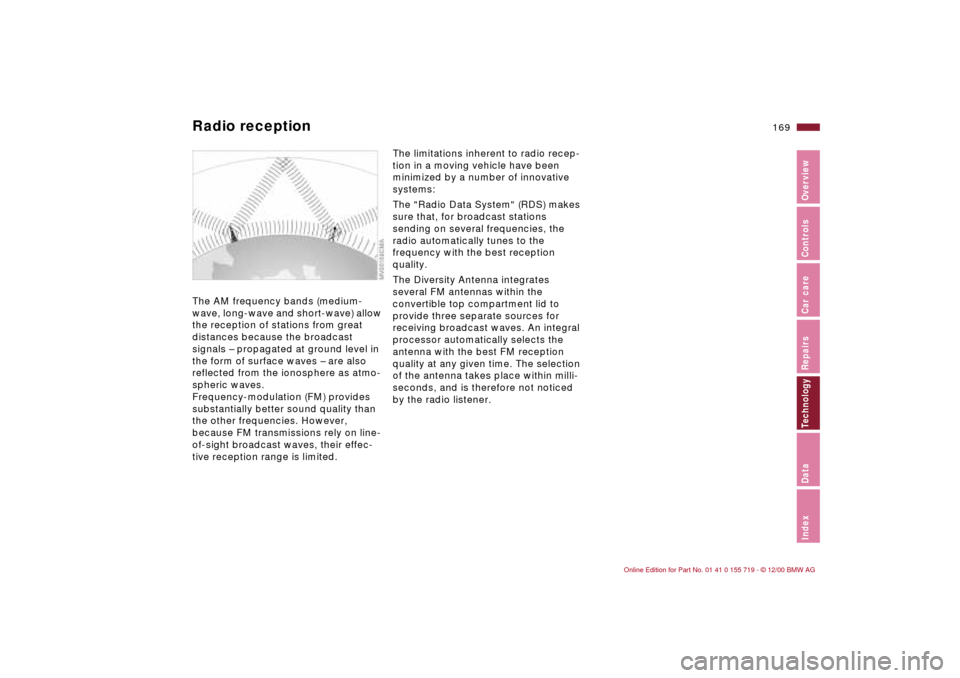transmission BMW M3 CONVERTIBLE 2001 E46 Owner's Manual
[x] Cancel search | Manufacturer: BMW, Model Year: 2001, Model line: M3 CONVERTIBLE, Model: BMW M3 CONVERTIBLE 2001 E46Pages: 195, PDF Size: 1.96 MB
Page 10 of 195

Contents
Overview
Controls and features
Cockpit16
Instrument cluster18
Indicator and warning lamps20
Multifunction steering wheel
(MFL)24
Hazard warning flashers25
Warning triangle25
Refueling26
Fuel specifications27
Tire inflation pressures27
Opening and closing:
Keys32
Electronic vehicle
immobilizer33
Central locking system33
Opening and closing – via the
door lock34
Opening and closing – via the
remote control35
Opening and closing – from
inside38
Luggage compartment lid39
Luggage compartment40
Alarm system42
Electric power windows44
Convertible top45
Adjustments:
Seats48
Mirrors52
Seat and mirror memory54
Steering wheel55
Car Memory, Key Memory55
Passenger safety systems:
Safety belts57
Transporting children safely58
Airbags61
Rollover protection system64
Driving:
Steering/Ignition lock66
Starting the engine66
Switching off the engine67
Parking brake67
Manual transmission68
Turn signal indicator/Headlamp
flasher69
Washer/Wiper system69
Rear window defroster71
Cruise control71
Everything under control:
Odometer73
Tachometer73
Engine oil temperature gauge73
Fuel gauge74
Coolant temperature gauge74
Service Interval Display75
Check Control76
Clock76
Computer77
Technology for safety and
convenience:
Park Distance Control (PDC)79
Dynamic Stability Control
(DSC)80
Tire Pressure Warning (RDW)81
M Engine dynamics control83
Contents
Page 31 of 195

Overview
Controls and features
Operation, care
and maintenance
Owner service procedures
Technical data
Index Advanced technology
31n
IndexDataTechnologyRepairsCar careControlsOverview
Driving:
Steering/Ignition lock66
Starting the engine66
Switching off the engine67
Parking brake67
Manual transmission68
Turn signal indicator/Headlamp
flasher69
Washer/Wiper system69
Rear window defroster71
Cruise control71
Everything under control:
Odometer73
Tachometer73
Engine oil temperature gauge73
Fuel gauge74
Coolant temperature gauge74
Service Interval Display75
Check Control76
Clock76
Computer77
Technology for driving comfort
and safety:
Park Distance Control (PDC)79
Dynamic Stability Control
(DSC)80
Tire Pressure Warning (RDW)81
M Engine dynamics control83Lamps:
Side lamps/Low beam
headlamps84
Instrument lighting84
High beams/Parking lamps85
Fog lamps85
Interior lamps86
Reading lamps86
Controlling the climate
for pleasant driving:
Automatic climate control88
Heated seats93
Cabin convenience:
Glove compartment94
Storage compartments95
Cellular phone96
Ashtray, front96
Cigarette lighter97
Ashtray, rear97
Loading and transporting
cargo:
Ski bag98
Cargo loading100
Roof-mounted luggage rack for
the hardtop101
Page 68 of 195

68n
Parking brake Manual transmission excessive pressure. Keep your thumb
pressed against the release button
while carefully pulling up the lever to
apply moderate pressure.
Excessive pressure can lead to over-
braking and loss of traction (fishtailing)
at the rear axle.
The brake lamps do not come on when
the parking brake is engaged.
Set the parking brake when parking on
steep hills, because under certain
conditions, putting the vehicle into first
or reverse gear may not be enough to
prevent it from rolling away.<
To avoid corrosion and one-sided
braking, apply the parking brake lightly
from time to time when coasting to a
standstill (at a traffic signal, for
instance), provided that it is safe to do
so. The shift lever's neutral plane is located
between 3rd and 4th gears.
When shifting from each gear into
"Neutral," the shift lever automatically
springs back to the gear lever's home
position.
When shifting gears in the 5th/6th-
gear plane, be sure to press the
gear lever to the right in order to
prevent inadvertent selection of a gear
in the 3rd/4th-gear plane.
Do not hold the vehicle in place on
slopes by slipping or "riding" the clutch.
Use the parking brake instead. Other-
wise, riding the clutch will cause
tremendous wear and tear to the
clutch.<
Reverse Select only when the vehicle is
stationary. Press the shift lever to the
left to overcome the slight resistance.
As you do this, the backup lamps will
turn on automatically when the ignition
key is in position 2.
Page 105 of 195

105n
IndexDataTechnologyRepairsCar careControlsOverview
Brakes: do not rest your foot on
the brake pedal while driving.
Even light but consistent pressure on
the brake pedal can lead to high
temperatures, brake wear and possibly
even brake system failure.
Aquaplaning: when driving on wet or
slushy roads, reduce vehicle speed. If
you do not, a wedge of water may form
between the tires and the road surface.
This phenomenon is referred to as
aquaplaning, or hydroplaning, and can
lead to partial or complete loss of
contact between the tires and road
surface, vehicle control and braking
ability.
Driving through water: do not drive
through water on the road if it is deeper
than 1 foot (30 cm), and then only at
walking speed at the most. Otherwise,
the vehicle's engine, the electrical
systems and the transmission may be
damaged.<
The catalytic converter reduces harmful
pollutants in the exhaust emissions.
It is designed for use with unleaded fuel
only. Even minute quantities of lead
would be enough to permanently
damage both the catalytic converter
and the system's oxygen sensor.
To ensure efficient, trouble-free engine
operation and to avoid potential
damage:
>Be sure to comply with the required
scheduled maintenance work and
repair procedures.
>Fill the fuel tank well before it is
empty.
>Tow-start only when the engine is
cold, otherwise unburned, residual
fuel in the catalytic converter could
ignite and cause damage. It is better
to jump-start the vehicle with outside
assistance.
>Avoid other situations where the fuel
is not burned, or burns incompletely,
such as engaging the starter
frequently or for extended periods, or
repeated start attempts in which the
engine does not start (stopping and
restarting an engine which is running
properly does not present a problem).
Never let the engine run with any of
the spark plug cables disconnected. Be sure to observe the instruc-
tions above to prevent unburned
fuel from reaching the catalytic
converter. Otherwise there is danger of
overheating and damage to the cata-
lytic converter.
High temperatures occur in any vehicle
equipped with a catalytic converter.
Heat shields are installed adjacent to
some sections of the exhaust system.
Never remove these shields; do not
apply undercoating to their surfaces.
When driving, standing at idle, and
parking the vehicle, take extra care to
avoid contact between the exhaust
system and flammable materials (grass,
hay, leaves, etc.). Such contact could
start a fire, resulting in personal injury
and property damage.<
Driving notes Catalytic converter
Page 108 of 195

108n
Disc brakesDisc brakes furnish optimum decelera-
tion and braking control with greater
fade resistance under heavy use.
Using your vehicle only occasionally,
leaving your vehicle parked for
extended periods, and making only
minimal demands on your brakes
promotes brake disc corrosion and
brake pad contamination, because the
minimal loads required for your disc
brakes to self-clean have not been
reached.
If the brake discs are corroded, they will
tend to respond to braking with a
pulsating effect that even extended
brake applications will fail to cure.
For your own safety: use only
brake pads that BMW has
approved for your particular vehicle
model. BMW cannot evaluate non-
approved brake pads to determine if
they are suited for use, and therefore
cannot ensure the operating safety of
the vehicle if they are installed.<
Driving notes When driving in wet conditions and in
heavy rain, it is effective to apply light
pressure to the brakes every few miles.
Be aware of traffic conditions to ensure
that this maneuver does not endanger
other road users. The heat which is
generated by the brake applications
helps to dry the brake pads and discs.
Maximum braking force is obtained
while the wheels are not locked, but
rather when they are still barely turning
immediately prior to locking. ABS main-
tains this state automatically. If the ABS
should ever fail, pump the brakes if
possible (refer to page 111).
Drive down long or steep descents in
the mountains using a gear that
requires the least amount of braking.
Doing this prevents putting excessive
loads on the brakes, which in turn
keeps the brake system from possibly
being damaged. Stay within the allow-
able engine speed range. For further
information, refer to page 73.
Braking effect on the engine can be
further increased by downshifting, into
first gear, if necessary. Should the braking effect from the
engine prove inadequate, you should
still avoid extended, continuous
braking. Instead, decelerate the vehicle
by stepping hard on the brake pedal
(while watching out for drivers behind
you), and, if necessary, continue to
decelerate by pumping the brakes
(staggered braking). This staggered
braking technique allows the brakes to
cool in the intervals between active
braking phases. This prevents over-
heating and ensures that full braking
capacity remains available at all times.
Do not coast with the clutch
depressed, with the shift lever in
neutral or with the engine shut off. The
engine does not provide any braking
effect with the transmission in neutral or
with the engine shut off.
Do not allow floor mats, carpets or any
other objects to protrude into the area
around the brake pedal, the clutch or
the accelerator which could obstruct
their freedom of movement.<
Page 128 of 195

128n
Engine oil manual transmission, the differential,
and the power steering system.<
Recommendation: have the oil changed
by your BMW center only.
Continuous exposure to used oil
has caused cancer in laboratory
testing. For this reason, thoroughly
wash any areas of skin that come into
contact with oil using soap and water.
Always store oils, grease and similar
materials so that they are inaccessible
to children. Comply with warning labels
and information on containers.<
Comply with the applicable envi-
ronmental laws regulating the
disposal of used oil.
of an engine. Based on extensive
testing, BMW approves only certain
types of engine oil.
Use only approved "BMW High Perfor-
mance Synthetic Oil."
If you are unable to obtain "BMW High
Performance Synthetic Oil," you may
use small volumes of other approved
synthetic oils for topping up between oil
changes. Use only oils with the specifi-
cation API SH or higher.
Ask your BMW center for details
concerning the specific "BMW
High Performance Synthetic Oil" or
synthetic oils that have been
approved.<
You can also call BMW of North
America at 1-800-831-1117 or visit this
website: www.bmwusa.com to obtain
this information.Viscosity ratings Viscosity is the oil flow rating as defined
in SAE classes.
The selection of the correct SAE class
depends on the climatic conditions in
the area where you drive your BMW.
Approved oils are in SAE classes
5W-40 and 5W-30.<
These kinds of oil may be used for
driving in all ambient temperatures.
Page 140 of 195

140n
Storing your vehicle
If you intend to store the vehicle
for more than 3 months, be sure to
follow the maintenance instructions on
this page.<
Storage preparationsHave your BMW center perform the
following procedures:
1 Clean and apply a rustproofing agent
or other treatment to the engine,
engine compartment, undercarriage,
axles and major components in
accordance with approved repair
procedures. First wash the vehicle
surface, then clean the interior,
following up with paint- and chrome
care, after which you clean the
rubber seals for the hood and doors.
2 Change the engine oil and oil filter
with the engine warm. As an addi-
tional corrosion protection measure,
an anticorrosive agent can be added
to the engine in accordance with the
manufacturer's instructions.
3 Check the coolant level and concen-
tration, top up if necessary.
4 Check the fluid level of the wind-
shield washer fluid reservoir; top up if
necessary.
5 Fill the fuel tank completely to
prevent the formation of condensa-
tion.
6 Increase the tire inflation pressure to
51 psi (350 Kilopascal).Before parking the vehicle1 To prevent the brake discs and
drums from corroding, dry the
parking and footbrake by applying
the brakes.
2 Park the vehicle in a covered, dry,
and well-ventilated area. Place the
transmission in first gear or, if neces-
sary, chock the wheels to prevent the
vehicle from rolling. Do not set the
parking brake.
3 Remove the battery, charge it
completely and store it in a cool (but
frost-free) room.
4 Remove the hardtop and store it
separately. Refer to page 114.
5 Close the convertible top.During storageRecharge the battery every six months.
If it is not recharged, it will not be
useable. Every time the battery is
discharged, especially over extended
periods, its service life is reduced.
Removing the vehicle from
storageRecharge the battery if the "Magic
Eye
*" turns black. Refer to page 157.
Then have Inspection I performed by
your BMW center, including a brake
fluid replacement if necessary.
Page 169 of 195

169n
IndexDataTechnologyRepairsCar careControlsOverview
The AM frequency bands (medium-
wave, long-wave and short-wave) allow
the reception of stations from great
distances because the broadcast
signals – propagated at ground level in
the form of surface waves – are also
reflected from the ionosphere as atmo-
spheric waves.
Frequency-modulation (FM) provides
substantially better sound quality than
the other frequencies. However,
because FM transmissions rely on line-
of-sight broadcast waves, their effec-
tive reception range is limited.
The limitations inherent to radio recep-
tion in a moving vehicle have been
minimized by a number of innovative
systems:
The "Radio Data System" (RDS) makes
sure that, for broadcast stations
sending on several frequencies, the
radio automatically tunes to the
frequency with the best reception
quality.
The Diversity Antenna integrates
several FM antennas within the
convertible top compartment lid to
provide three separate sources for
receiving broadcast waves. An integral
processor automatically selects the
antenna with the best FM reception
quality at any given time. The selection
of the antenna takes place within milli-
seconds, and is therefore not noticed
by the radio listener.
Radio reception
Page 181 of 195

181n
IndexDataTechnologyRepairsCar careControlsOverview
Capacities
Notes
Fuel tank
Reserve gal. (liters)
gal. (liters)approx. 16.6 (approx. 63)
approx. 2.1 (approx. 8)Fuel specification: page 27
Windshield washer system/
Headlamp washer system quarts (liters) approx. 5.6 (approx. 5.3) Specifications: page 126
Cooling system including heater circuit quarts (liters) approx. 7.1 (approx. 6.7) Specifications: page 129
Engine oil and filter change quarts (liters) approx. 5.8 (approx. 5.5) BMW High Performance
Synthetic Oil
Specifications: page 128
Manual transmission quarts (liters) approx. 1.9 (approx. 1.8) Changing the oil during the
Break-In Inspection, and at every
Inspection II
Differential quarts (liters) approx. 1.2 (approx. 1.1) Changing the oil during the
Break-In Inspection, and at every
Inspection II
Page 189 of 195

Everything from A to Z
189n
IndexDataTechnologyRepairsCar careControlsOverview
Headlamp flasher69, 85
Headlamp washer
system125, 126, 181
Heated mirror52
Heated seats93
Heater and ventilation88
Heavy loads100
Height50, 179
High beam lamps69, 85
indicator lamps23
High Performance Synthetic
Oils128
High-speed engine171
Holder for beverage
cans, refer to Beverage
holder
Hood121
opening121
unlocking121
Horn17IIce warning77
Identification number,
vehicle130
Identification, tires118, 120
Ignition key32
Ignition key position66
Ignition lock66
Imprint4
Indicator lamps20tIndividual settings
car memory, key
memory55
Inflation pressures115t
INSPECTION75
Instrument cluster18
Instrument lighting84
Instruments18
Interference
cellular phone112
Interior lamps36, 86
bulb replacement151t
remote control36
Interior mirror
automatic dimming
feature53
Interior motion sensor42
disarm43t
Interior rearview mirror
automatic dimming
feature53, 173
Intermittent operation69
JJump-starting164KKey Memory55
Keys32
with remote control32
LLamp switch84
Lamps
footwell lamps86
high beam headlamps85
instrument lighting84
interior lamps86
parking lamp85
reading lamps86
Lamps and bulbs146
LAMPS ON warning84
Lashing eyes101
LATCH attachment for child
seat59
Leather care136
Length179
License plate lamp
bulb replacement151t
Lighter97
Load-securing devices101
Low beam headlamps84
lamp malfunction147t
Lower rollover protection
system64t
Luggage
compartment40, 41
capacity180
emergency release39t
enlarging41
floor mat41
floor panel41fold down convertible top
compartment base41
remote control37
Luggage compartment
lamps39
bulb replacement152t
Luggage compartment
lid39
emergency release39t
Luggage rack101
Lumbar support49
MM Engine dynamics
control83
M Mobility system153
M+S-tires119
M3 engine concept171
Maintenance75, 131
Make-up mirror53
Malfunction of ABS107
Manual convertible
top operation in case of
electrical defect162t
Manual transmission68
Manual-shift gear lever68
Master key32
Maximum speed181
Memory54
MFL (Multifunction steering
wheel)24